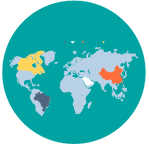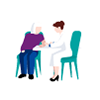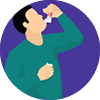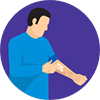Context



Atopic dermatitis, also known as atopic eczema, is a chronically relapsing skin disease that most commonly manifests in children. Although the exact cause is unclear, it is thought to be a combination of immune, genetic and environmental factors(a)(b)

Patients with AD have a dysfunctional skin barrier and biased immune response, which lead to:(a)(b)

AD affects 10–20%(c) of children and 1–10%(d) of adults in Western countries

The diagnosis of AD involves an assessment of clinical (essential, important and associated) features and medical history(a)
Features that must be present for a diagnosis of AD are severe itching of the skin and chronic rough/inflamed skin patches. Appearance and distribution of lesions often differs between age groups
Features that are common across AD patients and support diagnosis include early onset of symptoms (i.e. during childhood), personal/family history of atopy and abnormally dry skin
Features that are associated with AD and may suggest AD diagnosis include changes to the eye/surrounding eye, scaly skin, bumps on the skin, lateral thinning of the eye brows (Herthoge's sign), infraorbital folds (Dennie-Morgan sign), and hyper linearity of palms and soles

AD can have a significant impact on a patient’s quality of life and be burdensome for their families and the wider population. AD can negatively affect a patient’s academic, work and social life
Eichenfield LF, et al. Guidelines of care for the management of atopic dermatitis. section 1. Diagnosis and assessment of atopic dermatitis.J Am Acad Dermatol. 2014;70(2):338–351. doi:10.1016/j.jaad.2013.10.010;
Ring J, et al. Guidelines for treatment of atopic eczema (atopic dermatitis) Part 1. JEADV. 2012;26(8):1045-1060. doi:10.1111/j.1468-3083.2012.04635.x;
Weidinger S, et al. Lancet 2016;387(10023):1109-1122;
Fabbrocini G, et al. Treatment of Atopic Dermatitis with Biologic Drugs. Dermatol Ther (Heidelberg) 2018; 8(4):527-538. doi: 10.1007/s13555-018-0258-x
Atopic comorbidities
AD patients can also suffer from other atopic diseases such as:

Asthma
Approximately 50-70% of patients with severe AD develop asthma (in comparison to 8% of the general population)(a)(b)

Allergic rhinitis
An estimated 66-75% of patients with severe AD have/develop allergic rhinitis(a)(b)

Food allergies
There may be an association between AD and food allergies(a)(b)
Non-atopic comorbidities
AD is also associated with non-atopic conditions, including:

Psychological comorbidities
AD is linked to various mental health conditions, such as:(a)(b)(c)

Infections
Patients with AD are at risk of developing bacterial, viral and fungal skin infections(a)(b)
Simpson EL. Comorbidity in Atopic Dermatitis. Curr Dermatol Rep. 2012;1(1):29–38. doi:10.1007/s13671-011-0003-5;
Bantz SK, et al. The Atopic March: Progression from Atopic Dermatitis to Allergic Rhinitis and Asthma. J Clin Cell Immunol.2014;5(2):202. doi:10.4172/2155-9899.1000202;
Simpson EL, et al. Association of Inadequately Controlled Disease and Disease Severity With Patient-Reported Disease Burdenin Adults With Atopic Dermatitis.JAMA Dermatol. 2018;154(8):903–912. doi:10.1001/jamadermatol.2018.1572
Public stigmatisation of AD
Patients with visible skin diseases often suffer from public stigmatisation(a) which can negatively impact patient mental health
Psychological impact of symptoms and stigma
In addition to the psychological comorbidities, patients have reported feeling frustrated, isolated and embarrassed(b)
Financial strain of medical consultations and treatments
To control and manage AD symptoms, patients face significant direct and indirect financial costs(c)
Patients can face out-of-pocket expenses for medical consultations and potential loss of income (due to absenteeism)(d)
Ripple effect on families and care givers
Families and care givers of patients with AD can be impacted on a day-to-day basis. Parents of paediatric AD patients may experience distress/anxiety when attempting to manage their child’s symptoms(c)(d)
Augustin M, et al. Translating the WHA resolution in a member state: towards a German programme on 'Destigmatization' for individuals with visible chronic skin diseases. J Eur Acad Dermatol Venereol. 2019. doi: 10.1111/jdv.15682;
Zuberbier T, et al. Patient perspectives on the management of atopic dermatitis. Journal of Allergy and Clinical Immunology. 2006;118(1):226-32;
The Economist Intelligence Unit. A misunderstood skin disease: Mapping the policy response to atopic dermatitis [Website] https://eiuperspectives.economist.com/ healthcare/misunderstood-skin-disease-mapping-policy-response-atopic- dermatitis/white-paper/misunderstood-skin-disease- mapping-policy-response-atopic-dermatitis Accessed 10 Oct 2019;
Drucker AM, et al. The Burden of Atopic Dermatitis: Summary of a Report for the National Eczema Association. Journal of Investigative Dermatology. 2017;137(1):26-30
Indirect costs due to productivity loss
AD symptoms and AD-associated comorbidities result in productivity loss

An estimated 5.9 million workdays per annum are lost due to AD in the US(a)

In the Netherlands, a study reported total average direct costs for treating AD as €5,191 per patient per year. The cost to productivity was calculated as €10,040 per person per year(b)(1)
Note: (1) Study group of 70 people

A 4-week long US study of 2-12 year-old AD patients reported that 8% of children lost at least 1 day of school due to AD and 9% of caregivers lost at least 1 day of work due to their child’s AD(c)
Wider economy
There are various reports on the economic impact of AD in different countries, all of which highlight the substantial burden AD has on the economy

The total annual cost in the United Kingdom is estimated to be approximately $598 million USD (£465 million), of which $380 million (£297 million) is incurred by
patients(d)

In the United States, the national cost of managing AD is estimated to be up to $3.8 billion US dollars per year(e)

In Singapore, the total cost per annum per paediatric AD patient is approximately $1,097(f)
Silverberg JI. Health Care Utilization, Patient Costs, and Access to Care in US Adults With Eczema:A Population-Based Study.JAMA Dermatol.2015;151(7):743–752. doi:10.1001/jamadermatol.2014.5432;
Adriens LFM. et. Al. Economic Burden of Adult Patients with Moderate to Severe Atopic Dermatitis Indicated for Systematic Treatment. Acta Derm Venereol. 2019;99(9):762-768. doi: 10.2340/00015555-3212;
Drucker A, et al. The Burden of Atopic Dermatitis: Summary of a Report for the National Eczema Association. Journal of Investigative Dermatology. 2017;137(1):26-30. doi: 10.1016/j.jid.2016.07.012;
Sach TH, et al. Economic evidence for the prevention and treatment of atopic eczema: a protocol for a systematic review.Syst Rev. 2016;5:90. doi:10.1186/s13643-016-0262-0;
Mancini AJ, et al. The socioeconomic impact of atopic dermatitis in the United States: a systematic review. Pediatr Dermatol. 2008;25(1):1-6. doi: 10.1111/j.1525-1470.2007.00572.x;
Tsai TF, et al. Burden of atopic dermatitis in Asia. Journ of Derm 2019;46. doi: 10.1111/1346-8138.15048.
Topical treatments
The regular and liberal use of emollients and moisturisers form the basis
of every AD therapy. Topical corticosteroids are also recognised as a
significant component of AD care. Finally, topical calcineurin inhibitors,
antimicrobials and antiseptics may also be recommended to support
management of AD
symptoms(a)(b)
Conventional systemic treatment
Systemic treatments can be administered orally or by
injection, both of
which can help with managing AD
symptoms (e.g. systemic oral immunosuppressants)(a)(b)
Other oral medications (non-systemic) may include antimicrobials (for patients with bacterial infections) and antihistamines (for short-term use in patients with sleeploss secondary to itch)(a)(b)
Biologics
Currently, AD injections are recombinant therapeutic proteins that target specific inflammatory cells and mediators. Patients with severe AD, refractory to topical and oral treatments, may benefit from these injections(a)(b). Biologics will soon involve pills as well
Disease flare
A combination of pharmacological (e.g. topical
corticosteroids) and non-pharmacological
treatments (e.g. wet wraps) can rapidly improve
AD symptoms(a)(b)
Non-pharmacological treatments
Education
Education can enhance medical treatment by providing patients with new knowledge or skills about AD management(b)
Psychosocial support
Psychotherapeutic approaches, such as counselling and therapy, may support the psycho-social facet of AD(b)
Emollient therapy and skin care
Given that dry skin is a major symptom of AD, frequent application of moisturizers and thorough cleansing of the skin are core components of AD skin care. The skin should remain hydrated and soap substitutes utilised where possible(a)(b)
Avoidance of triggers
Patients with AD should avoid, where possible, known physical or biological irritants such as wool and dust mites(a)(b)
Eichenfield LF, et al. Guidelines of care for the management of atopic dermatitis. Section 2. Management and treatment of atopic dermatitis with topical therapies J Am Acad Dermatol. 2014;71(1):116–132. doi: 10.1016/j.jaad.2014.03.023;
Ring J, et al. Guidelines for treatment of atopic eczema (atopic dermatitis) Part 1. JEADV. 2012;26(8):1045-1060. doi:10.1111/j.1468-3083.2012.04635.x
Objective Outcome Measures/Physician-led
AD scoring indices utilised to monitor patients and their disease include:
EASI |
Eczema Area and Severity Index |
SCORAD |
SCORing Atopic Dermatitis |
vIGA-AD |
Validated Investigator Global Assessment for Atopic Dermatitis |
BSA |
Body Surface Area |
Patient-Reported Outcome Measures
Quality of life for AD patients can be measured by:
DLQI |
Dermatology Quality of Life Index |
PaGA |
Patient Global Assessment |
POEM |
Patient-Oriented Eczema Measure |
Itch NRS |
Itch Numeric Rating Scale |
EASI for clinical signs: Harmonising Outcome Measures for Eczema (HOME); [Website] http://www.homeforeczema.org/research/easi-for-clinical-signs.aspx Accessed 13 Mar 2019;
SCORing Atopic Dermatits (SCORAD) Calculator (0.9.0). [Website] http://scorad.corti.li/Accessed 26 Feb 2019;
Validated Investigator Global Assessment For Atopic Dermatitis (vIGA-AD™) Scale [PDF] https://www.eczemacouncil.org/wp-content/uploads/2018/02/Validated-Investigator-Global-Assessment-Scale_vIGA-AD_2017.pdf Accessed 26 June 2019;
Chopra R, et al. Severity strata for Eczema Area and Severity Index (EASI), modified EASI, Scoring Atopic Dermatitis (SCORAD), objective SCORAD, Atopic Dermatitis Severity Index and body surface area in adolescents and adults with atopic dermatitis. Br J Dermatol. 2017;177(5):1316-1321. doi: 10.1111/bjd.15641;
Lewis V, et al. 10 Years Experience of the Dermatology Life Quality Index (DLQI). J Investig Dermatol Symp Proc 2004;9:169–180;
Al-Dhubaibi MS. The effectiveness of alitretinoin for the treatment of chronic hand eczema: A meta-analysis. Int J Health Sci (Qassim). 2018;12(2):70–79;
Charman CR, et al. Translating Patient-Oriented Eczema Measure (POEM) scores into clinical practice by suggesting severity strata derived using anchor-based methods. Br J Dermatol. 2013;169(6):1326–1332;
Numerical Rating Scale (NRS) [Website] http://www.pruritussymposium.de/numericalratingscale.html Accessed 14 Apr 2019